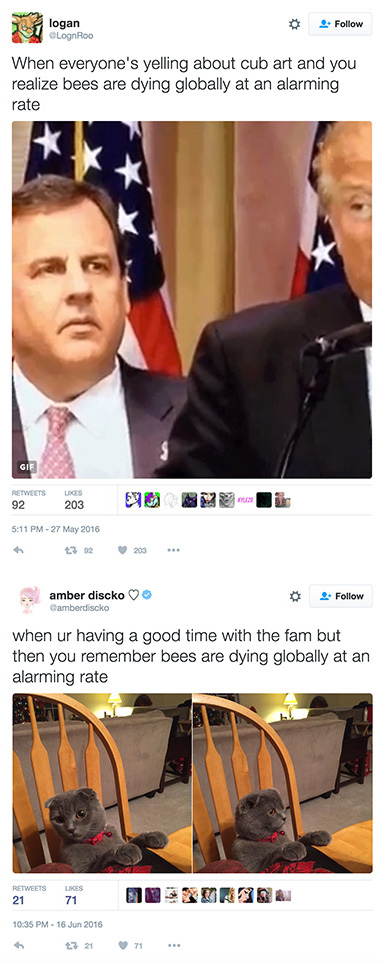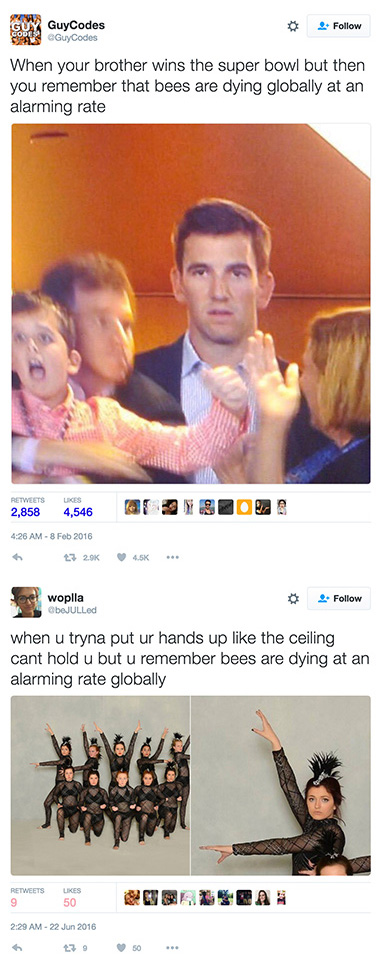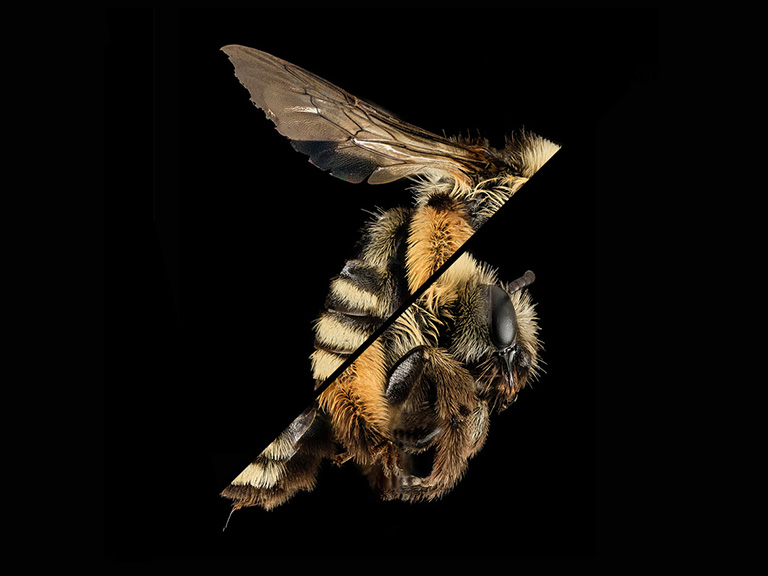It has come to our attention—and it is an alarming piece of news, to be sure—that it may be that bees are experiencing an alarming rate of attrition, and that it is happening all over the world, though that is not yet confirmed, but it is certainly very alarming indeed
IT'S a Saturday night at an idyllic house party. There are constant trills of too-loud laughter, an endless supply of beer sloshing around in red Solo cups. Everyone is smiling or chattering away, except for one lone face, eyes glazed over, as if seeing the totality of human existence through a roll of toilet paper. The surrounding crowd has wound down into slow motion, and Gary Jules’s “Mad World” twinkles around the familiar act of remembering once again: bees are dying globally at an alarming rate.


“The bees are dying globally at an alarming rate” is our darkest meme. It’s usually pasted above a despondent face, blank with the tragic realization of our impending fate, though the impact of the sentence doesn’t need visual aid. Even without the traditional corresponding image of a dead-eyed Peyton Manning watching his brother’s win of the 2016 Super Bowl -- as appears to be the major catalyst into mainstream popularity -- it is a statement of existential doom. The bees are dying globally at an alarming rate, and there is nothing we can do about it. Or maybe there is something we can do about it? But we won’t. The hopelessness attached to either possibility is great for comedy.
The meme is unique in that “The bees are dying globally at an alarming rate” is an explicit statement of fact. Yet the reason the bees are dying globally at an alarming rate is un-Googleable. The scientific community’s lack of definitive explanation makes it impossible to unearth concrete answers, while the proliferation of the meme only obscures the question further. Adding to the conundrum is the fact that Colony Collapse Disorder (CCD) is just a name for the phenomenon; as the Environmental Protection Agency defines it, CCD “occurs when the majority of worker bees in a colony disappear and leave behind a queen, plenty of food and a few nurse bees to care for the remaining immature bees and the queen.” CCD is the meme without the meme: the fact that bees are dying globally at an alarming rate, and no more.
In their definitive report on the subject, the New York Times introduced bee fatality statistics with an entire paragraph on the 1857 mystery of the Mary Celeste; on seeing bees disappearing from hives, the phenomenon was first named, in Britain, after a notorious ghost ship. It’s entrancing and poetic. Until you recall that the bulk of our agricultural production relies on bees.
“The centrality of bees to our collective well-being is hard to overstate,” noted author Clyde Haberman, as if it were a side note in an eccentric trend piece. “They pollinate dozens of crops: apples, blueberries, avocados, soybeans, strawberries, you name it.” In addition to these fun fruits, bees are also, possibly, necessary for the future of the human race. When the phenomenon gained more traction, the National Resources Defense Council published a piece “assessing our chances of survival” in a world without honeybees, and ultimately argued that “humans would probably not go extinct (at least not solely for that reason).”
Truly, “humans would probably not go extinct” is the ¯\_(?)_/¯ of apocalyptic diagnoses, the kind of science for which only memes can provide a rational response.
The White House’s first national strategy to save the bees back in May of 2015 was similarly convoluted, with a TL;DR summary that was simply a paraphrasing of the meme. “Pollinators are critical to the Nation’s economy, food security, and environmental health,” wrote Director of the Office of Science and Technology Policy John P. Holdren at the top of the announcement. “Learn more.”
When you realize that the government’s solution to a cataclysmic environmental problem is that same useless repetition of the threat, the meme feels markedly less silly. “Just an FYI, America, bees are dying globally at an alarming rate. ¯\_(?)_/¯.” And like the meme itself, “learn more” is a self-unfulfilling prophecy. The three-step strategy for solving CCD includes one whole step about increasing the number of butterflies -- isn’t this about bees? -- and no real practical means of increasing the number of bees. Only towards the end of the post is there anything for YOU to do:
YOU can share some land with pollinators -- bees, butterflies, other insects, birds, bats -- by planting a pollinator garden or setting aside some natural habitat. YOU can think carefully before applying any pesticides and always follow the label instructions. YOU can find out more about the pollinator species that live near you.
It’s odd for such an urgent, all-caps second person to be taken on as almost an afterthought, but perhaps galvanization is irrelevant when the options for individual involvement are so trivial. Planting a home garden as a solution to CCD is only slightly less impactful than publishing think pieces on gun violence. If they are small tasks that the optimist hopes will add up to a greater whole, they mostly make us feel slightly better about the state of our rapidly disintegrating planet, while truly doing nothing at all. Except, you know, posting a meme.
Scientists and distraught beekeepers first noticed that the bees were dying globally at an alarming rate around 2006. They cited the proliferation of monoculture in agricultural practice, toxic pesticides, and the tainted breeding of queen bees. Or, as the United States of Agriculture put it in what may as well be a deliberate effort to make people even more confused: “Most research has pointed to a complex of factors being involved in the cause of CCD, and possibly not all of the same factors or the same factors in the same order are involved in all CCD incidents.”
Global warming probably has something to do with the bees dying globally at an alarming rate, but like global warming itself the plausible solutions are too massive in scope to seem possible, if not unworthy of the effort. It’s like there’s a gaping wound in the Earth, too big and icky to even bother with. Why spend the time and money to build a giant Band Aid, when we can just let it fester with infection, hoping we die before the gangrene sets in?
But all possible causes have one thing in common: us. Whether it was monoculture, or pesticides, or breeding, or -- the most likely scenario -- a combination of all three plus global warming, it adds up to us meddling with ecosystems, disregarding their careful balance in favor of prioritizing profit, and then proceeding to treat that unabashed, capitalistic lust as if is some uncontrollable alien force that can’t be tamed.
But that’s easy. We’re good at identifying problems, softening their blow, and then easing ourselves into continuing to catapult the Earth towards ruination. There is a barricade of language and awareness-raising bordered up around the potential for action, even when there are concrete solutions available. As the problem-solving grows more abstract, our shared sense of inefficacy heightens to a point of paralysis. We are left are frozen in inaction, simply regurgitating the vacuous observation that, ugh, everything is terrible.
The meme-ification of the bees hits on this in layers. It focuses on one of the most dire of our environmental issues, while further obscuring it as a mainstream inside joke. Simply commenting on the lack of momentum gained by efforts to spread awareness becomes a paradoxical act of complacent inefficacy. It’s knowing no one will do anything to help stop the bees from dying globally at an alarming rate, and also willfully doing nothing. Thus, the meme itself sets up a dysfunctional feedback loop, which becomes the cause and effect of its own mounting popularity. We’re citing the problem of refusing to fix problems, refusing to fix that problem ad nauseum, and then being depressed by the impossibly frustrating lack of problem-fixing.
But then, we know this already. The meme’s self-aware digestibility is the reason it’s funny in the first place. It paints an absurdist candy-coating around a rotten core of truth, poking at our shared sense of existential doom in hopes explicit acknowledgement will numb the pain of our inescapable inner darkness (haha). Beyond that, the bees represent the greater tragedy of the information age: an overabundance of awareness and total lack of action. Only, in becoming aware of our stagnation, we’re clamoring around for ways to soften the mounting itchiness of our shared cognitive dissonance. Our action, or lack thereof, is inconsistent with our understanding of a need for change. Since there’s far too much evidence of a need for action, but no increase in acting, we’ve altered our perception of the whole mess to be one of palpably sad irreverence.
The “colony” in CCD refers to the bees. But, of course, we’re also a colony that has collapsed. It’s clear the ends (of greatest possible production) no longer justify the means (of monoculture or whatever else is Mary Celeste-ing our pollinators), and that won’t be any less true because we’ve managed to flip the pure horror of the facts into a catchy joke. There’s certainly a far more macro implosion occurring, and these, tiny, wildly consequential insects seem to simply be the first fraying of our burnt edges. Perhaps the thing that truly needs rearranging is the infrastructure in which we cite problems and solve them. Perhaps. Anyway, all I know for sure is that bees are dying globally at an alarming rate.
